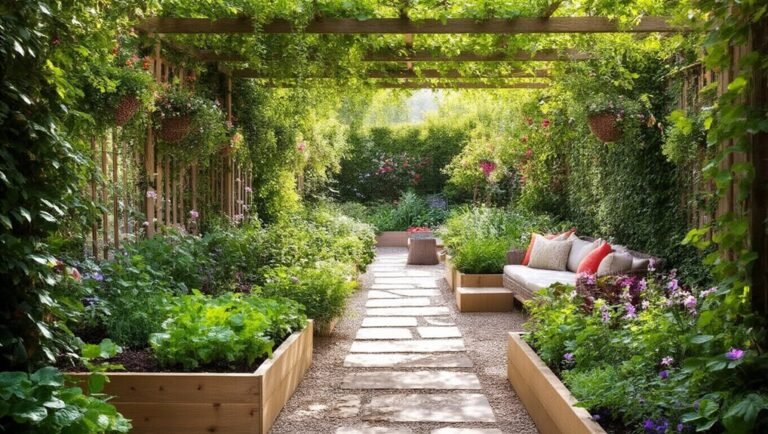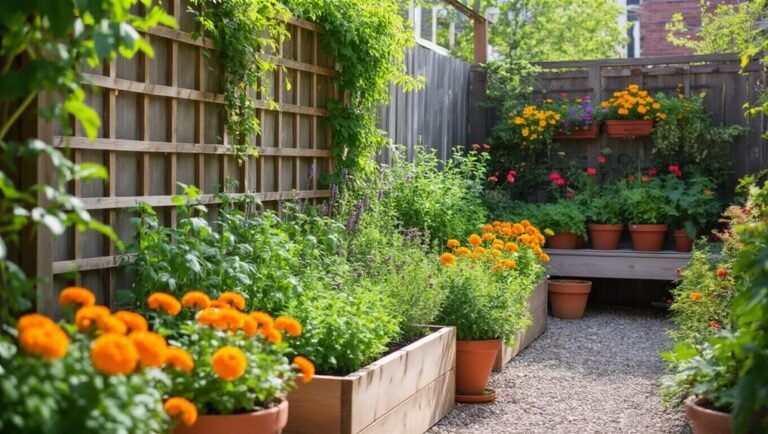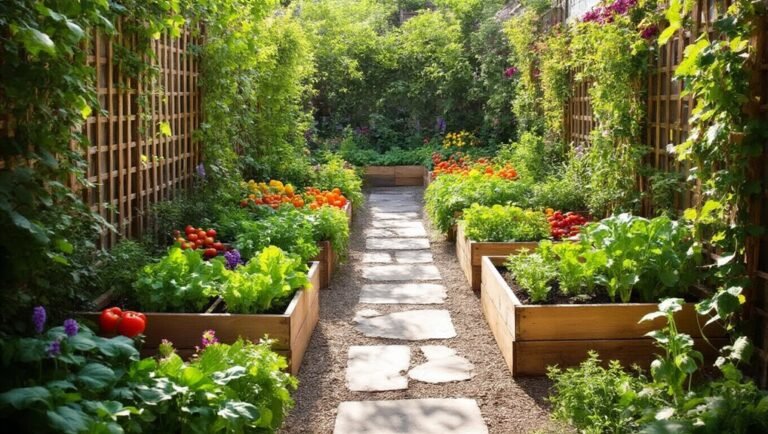Transform any room with indoor plants by first choosing varieties suited to your light and humidity levels. Consider height and scale to create visual interest, and use decorative pots that match your decor style. Group plants for impact and create layered heights with plant stands. Don’t forget to hang plants for added dimension. To keep your plants thriving, maintain a consistent care routine. Get ready to discover even more styling tips and tricks!
Key Takeaways
- Select plants based on light and humidity levels to ensure they thrive in your space.
- Layer plants by height and group them in odd numbers for visual interest and balance.
- Choose decorative pots that match your room’s style to enhance overall decor.
- Use hanging planters and stands to create layered heights and save floor space.
- Maintain a consistent care routine, adjusting plant placement according to seasonal light changes.
Choose the Right Plants for Your Space
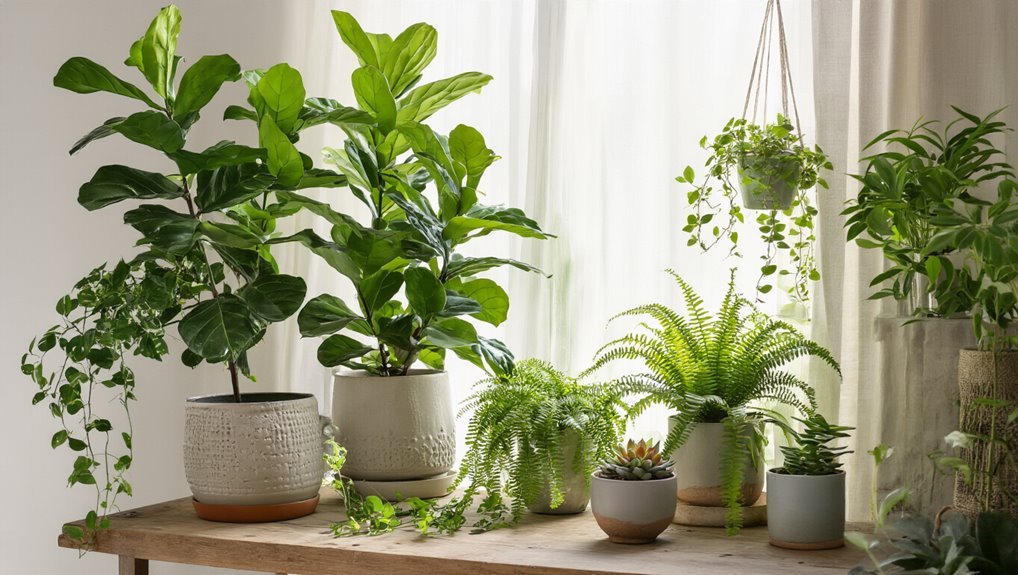
When you’re selecting plants for your space, consider the amount of light and humidity available, as these factors greatly influence your plants’ health and growth.
If your room gets plenty of natural light, you can opt for sun-loving varieties like succulents or snake plants. In low-light areas, however, choose resilient plants like pothos or ZZ plants that thrive in shade. If you want to enjoy fresh flavors and greenery, indoor herb gardens offer a practical and beautiful way to bring life to your home.
Humidity also plays a crucial role—tropical plants like ferns and peace lilies need higher humidity levels to flourish. If your space is dry, you might want to mist these plants or use a humidifier.
Always remember to think about how much care you’re willing to commit. Choosing the right plants means finding a balance between aesthetics and your environment’s conditions.
For those looking to grow herbs indoors with ease, consider starting with Herb Garden Kits with Seeds and Pots, which provide everything you need to cultivate a thriving indoor herb garden.
Consider Plant Height and Scale
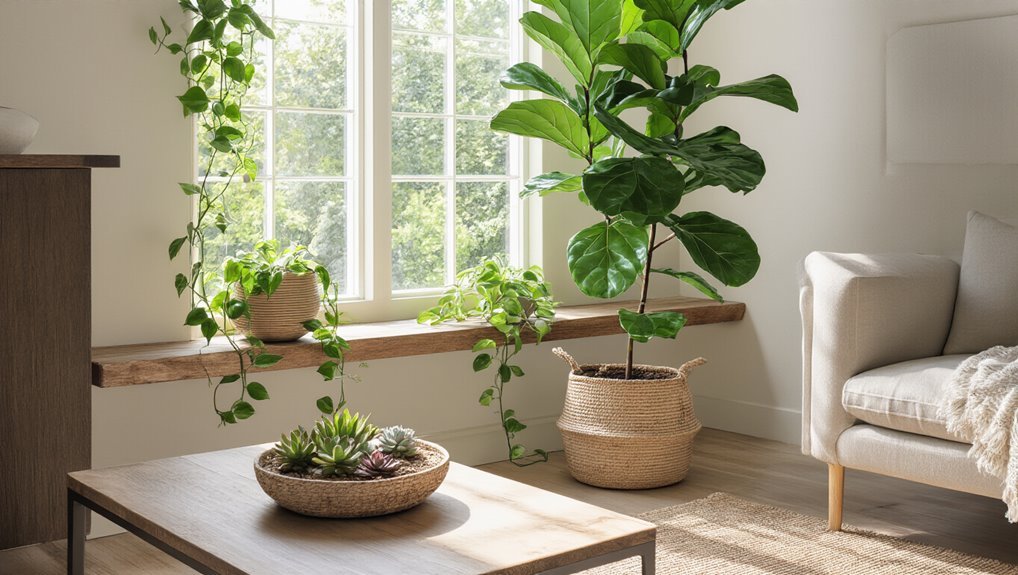
Plant height and scale are essential elements to consider for creating a balanced and visually appealing indoor garden. When arranging your plants, think about the height differences and how they interact within the space.
Tall plants, like fiddle leaf figs, can serve as striking focal points, while shorter plants, such as succulents, can fill in lower spaces. Layering plants by height adds dimension and draws the eye around the room. Adding decorative plant stakes can further enhance the visual interest of your arrangement and provide extra support for taller plants.
Make sure to avoid clustering all your tall plants together; instead, mix heights to create visual interest. Also, consider the scale of your furniture and room size—larger spaces can accommodate bigger plants, while smaller rooms benefit from more compact options.
This thoughtful arrangement will enhance your indoor oasis. Choosing the right plant pots is just as important, as stylish containers can elevate your entire space and complement your indoor garden design.
Use Decorative Pots and Planters
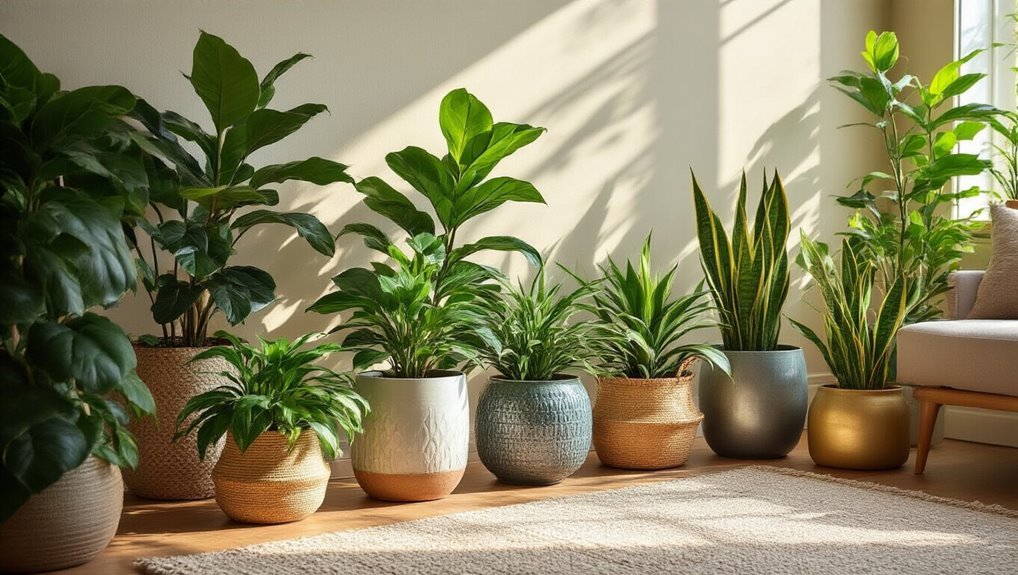
While you might focus on the plants themselves, the choice of decorative pots and planters can significantly elevate your indoor garden’s aesthetic. Selecting the right pots can create a cohesive look and enhance your room’s style. Consider materials, colors, and shapes that complement your decor. For an easy way to add vertical interest and save floor space, explore the benefits of hanging planters for both style and function.
Here’s a quick guide to help you choose:
| Pot Type | Best For |
|---|---|
| Ceramic | Modern and elegant |
| Terracotta | Rustic and natural |
| Metal | Industrial chic |
| Plastic | Versatile and lightweight |
Mix and match different styles for a unique flair, but ensure they harmonize with your room. Investing in eye-catching planters can make your plants stand out, transforming your space into a vibrant oasis. For an added touch of height and design, consider displaying your favorite pots on stylish plant stands, which can help elevate your greenery in any space.
Group Plants for Visual Impact
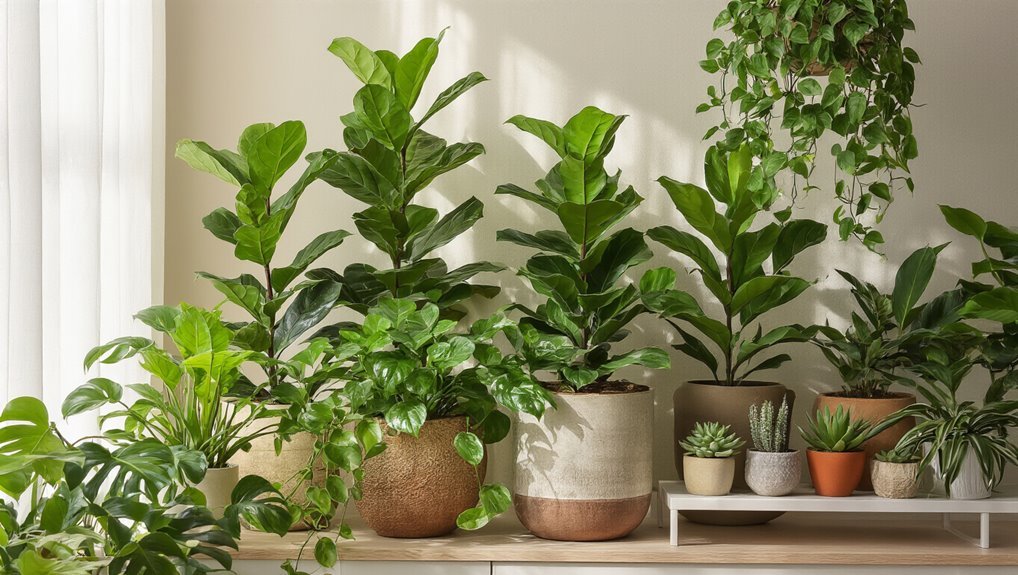
Grouping plants not only enhances their visual appeal but also creates a more dynamic and inviting space.
Start by selecting plants with varying sizes, shapes, and textures to create interest. Use odd numbers when arranging them—this often feels more natural and balanced. Incorporating a plant propagation station into your display allows you to showcase growing cuttings alongside mature plants for added depth and botanical intrigue.
Place taller plants in the back and shorter ones in front to ensure each one stands out. Consider clustering plants together in groups of three or five to make a statement.
You can also mix different types of foliage or colors to create a cohesive look. Finally, use trays or decorative surfaces to unify the arrangement.
For added convenience and healthier plants, consider using Self-Watering Planters to minimize maintenance and ensure your greenery thrives.
With thoughtful grouping, you’ll transform any corner into a lush and engaging focal point that draws the eye and brings life to your room.
Create Layered Heights With Stands
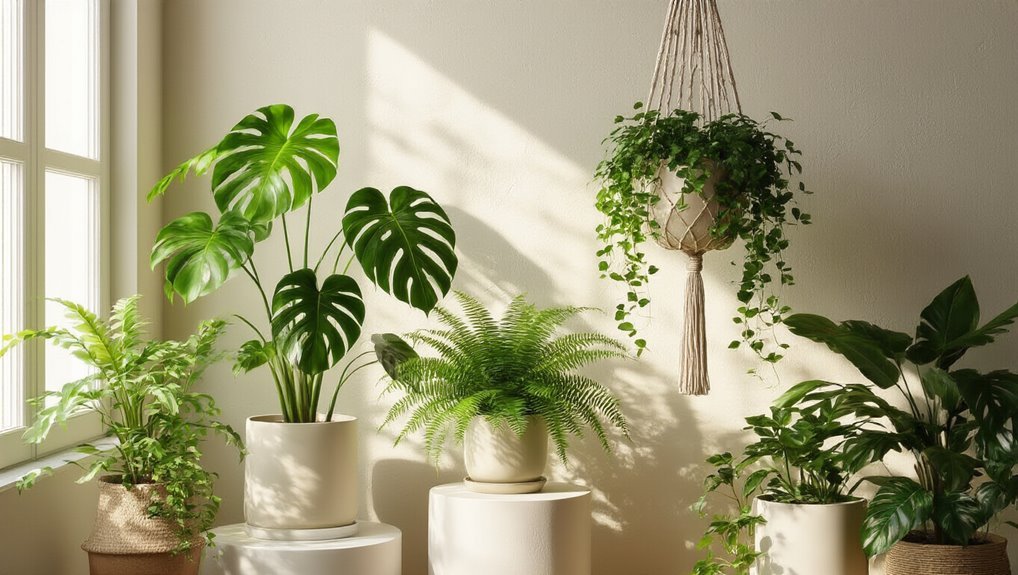
To elevate your indoor plant game, consider using stands to create layered heights that add depth and dimension to your space. By mixing different stand heights, you can highlight your plant’s unique shapes and textures. Use taller stands for large plants and shorter ones for smaller varieties, ensuring each plant gets the attention it deserves. For even more visual interest, you can complement your plant stands with Vertical Garden Kits to showcase a living wall of greenery. If you want to keep your indoor gardening tools tidy, consider incorporating Garden Tool Organizers into your setup for effortless organization.
Here’s a quick reference table to help you choose the right stands for your plants:
| Plant Type | Recommended Stand Height | Style Suggestion |
|---|---|---|
| Small Succulents | 6-12 inches | Minimalist metal stand |
| Medium Ferns | 12-24 inches | Rustic wooden pedestal |
| Large Foliage | 24-36 inches | Bold ceramic base |
| Trailing Vines | 12-18 inches | Decorative ladder stand |
Incorporate Plants Into Shelving
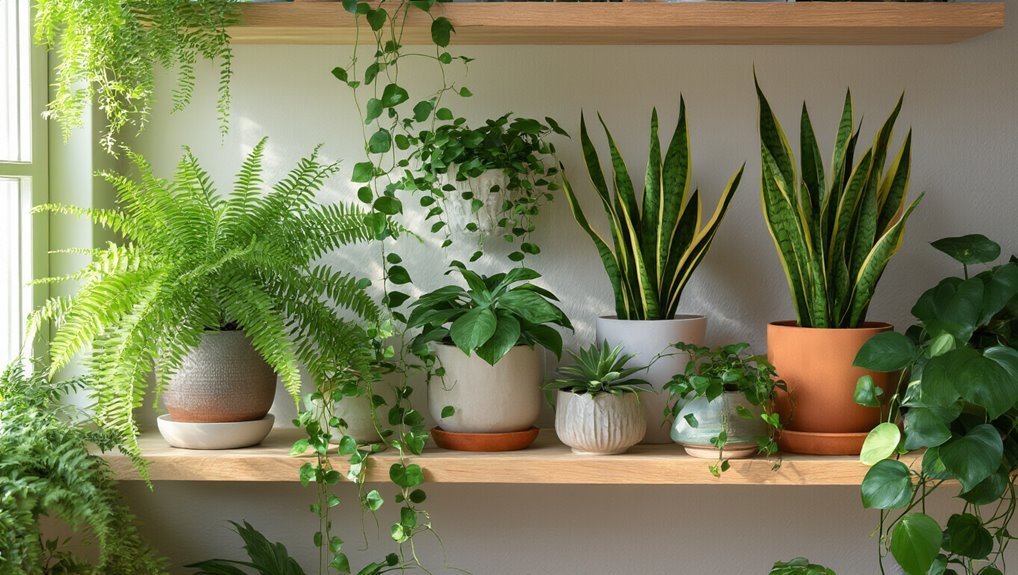
Incorporating plants into your shelving can transform a simple display into a vibrant focal point, enhancing both aesthetics and air quality. When arranging your indoor jungle, don’t forget to protect your hands with essential gardening gloves for every green thumb.
Here are some tips to get you started:
- Mix Heights: Combine short and tall plants to create visual interest. Use plant stands to elevate certain pieces.
- Vary Textures: Choose a variety of leaf shapes and colors. This contrast will keep your shelving dynamic and engaging.
- Create Groupings: Cluster plants in threes or fives for a cohesive look. Vary the sizes and styles within the group for added charm.
For plant enthusiasts who want to track their progress and success, keeping a gardening journal for record keeping can help you monitor plant growth and care routines right alongside your stylish displays.
Hang Plants for Added Dimension
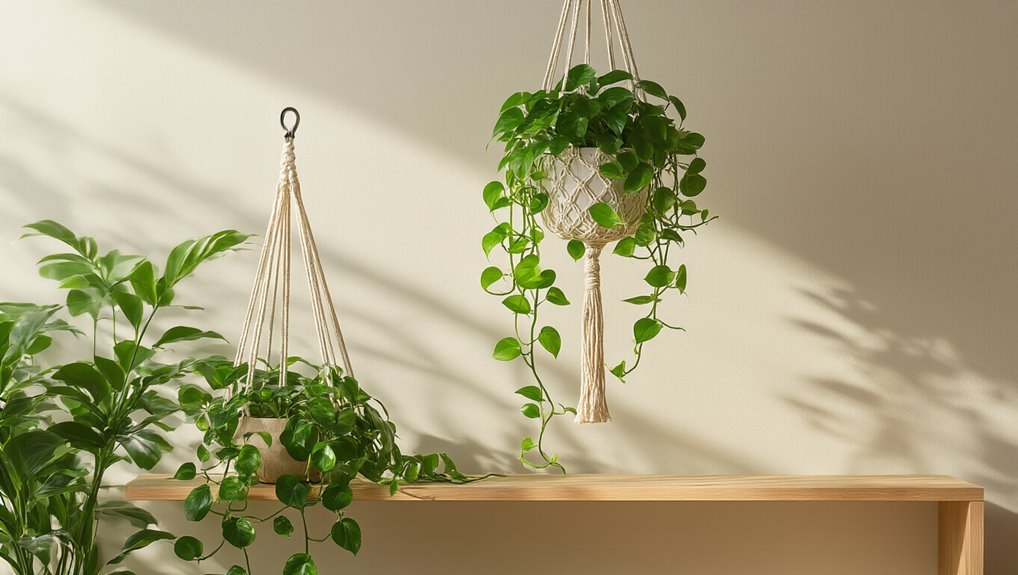
Hanging plants add a new layer of dimension to your indoor space, complementing the shelves you’ve styled. They draw the eye upward, creating a more dynamic environment. Adding garden gnomes to your plant displays can further brighten your space and introduce a whimsical outdoor touch indoors.
Consider using macramé hangers or wall-mounted planters to showcase trailing vines, like pothos or string of hearts. These plants not only save floor space but also introduce lush greenery at varying heights.
To achieve a balanced look, mix different lengths and types of hanging plants. You can also group them in clusters for added impact.
Be mindful of light conditions; ensure your plants receive adequate sunlight or choose low-light varieties if needed.
For outdoor inspiration, look to Decorative Birdhouses for Gardens as unique accents that enhance both style and function in your green spaces.
Use Plants as Focal Points
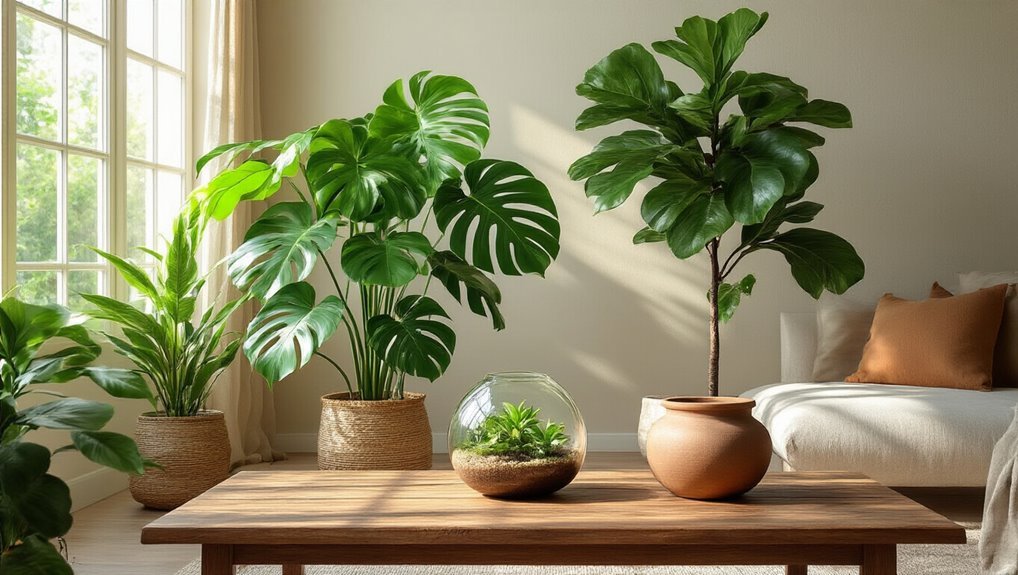
While many elements contribute to your interior design, using plants as focal points can transform a space and draw attention where you want it.
Choose the right plants to create visual interest and enhance your room’s aesthetic. Here are three tips to effectively use plants as focal points:
- Select Statement Plants: Opt for large, bold plants like a fiddle leaf fig or a snake plant to make an immediate impact. For bonsai lovers, essential bonsai care helps keep these unique statement plants thriving and looking their best.
- Group for Impact: Cluster smaller plants in varying heights together for a dynamic look that captures the eye.
- Position Strategically: Place your focal plant near furniture or art to create a harmonious flow that invites exploration.
Using Plant Care Kits ensures your focal plants stay healthy and vibrant, making them even more effective as statement pieces in your decor.
Mix and Match Textures and Colors
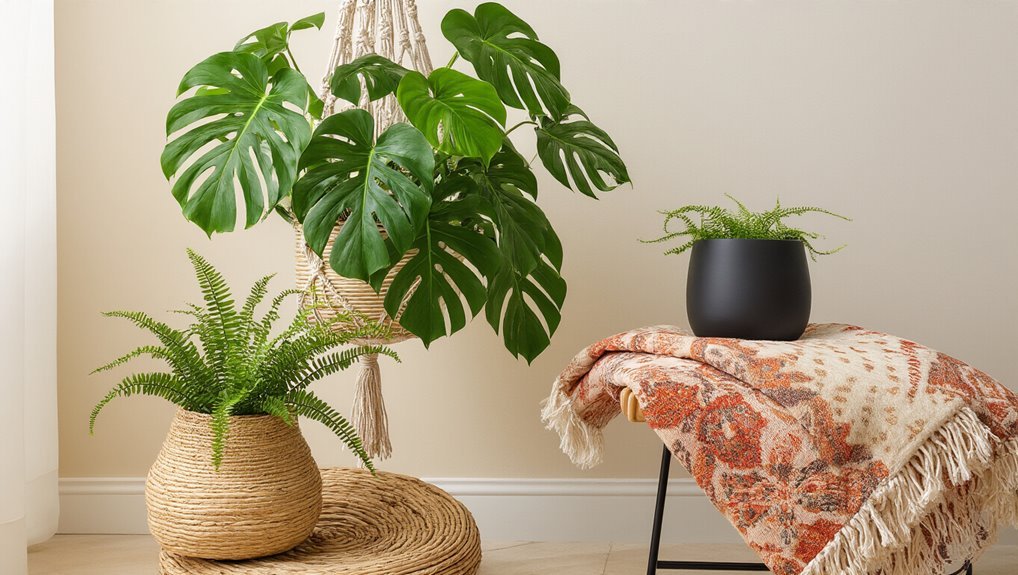
Using plants as focal points sets a strong foundation for your interior design, but mixing and matching textures and colors can elevate your space even further.
Start by selecting a variety of pots—ceramic, woven, or metallic—to create visual interest. Pair bold, leafy greens with softer, delicate plants for contrast. Don’t be afraid to play with colors too; a bright pot can pop against deep green foliage.
Incorporate different heights and shapes to enhance depth; tall plants can frame shorter ones beautifully. You might also consider incorporating natural elements like wood or stone to complement your plants.
This mix won’t only make your space feel dynamic but also bring warmth and personality into the room.
Maintain Consistent Care and Maintenance
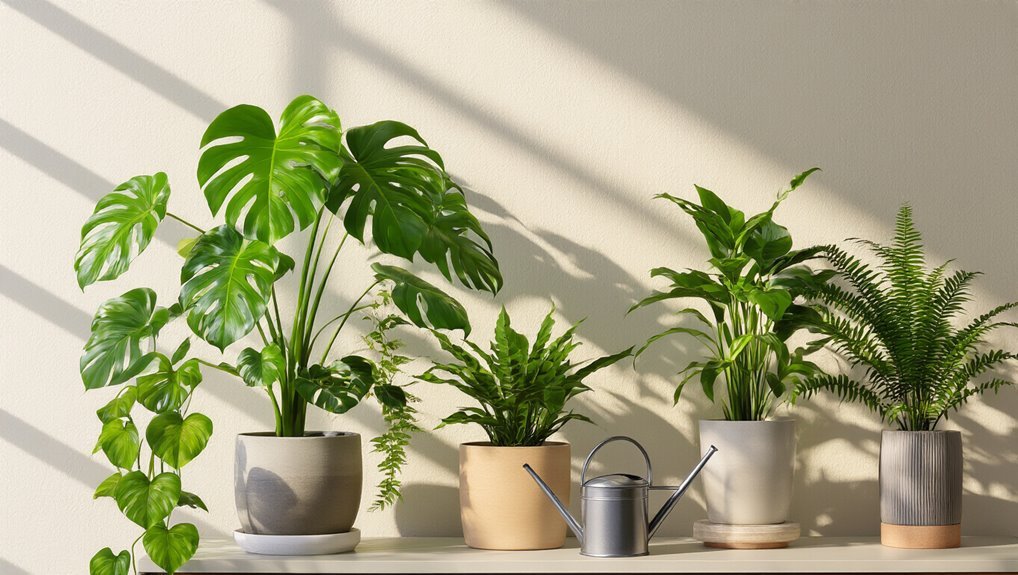
To ensure your indoor plants thrive, it’s essential to maintain consistent care and maintenance. Neglecting your plants can lead to unhealthy growth or even death.
Here are three key aspects to focus on:
- Watering: Check the moisture level regularly. Overwatering can lead to root rot, while underwatering can cause wilting. Aim for a consistent watering schedule.
- Light: Position your plants according to their light needs. Some thrive in bright, indirect light, while others prefer low-light conditions. Adjust their placement as the seasons change.
- Fertilizing: Feed your plants with the appropriate fertilizer during their growing season. This boosts their health and enhances their appearance.
Frequently Asked Questions
How Do I Choose Plants Based on Room Lighting?
To choose plants based on room lighting, assess your space’s light levels. For bright areas, opt for succulents or cacti. In low-light spots, consider snake plants or pothos. Always match plants to their environment for best results.
Can I Use Artificial Plants for Styling?
Absolutely! Artificial accents offer alluring aesthetics without the hassle of upkeep. You can create captivating corners or cozy nooks using them. Just ensure they complement your color scheme and overall style for stunning visual appeal.
What Are the Best Plants for Pet-Friendly Homes?
When choosing plants for pet-friendly homes, consider spider plants, Boston ferns, or bamboo palms. They’re non-toxic and safe for curious pets. Keep your furry friends in mind while creating your green sanctuary!
How Often Should I Rotate My Plants for Even Growth?
To encourage even growth, you should rotate your plants every few weeks, adjust their position regularly, and ensure they receive balanced light. This simple practice keeps your plants thriving and looking their best.
Are There Specific Plants That Purify Indoor Air?
Yes, some plants are known to purify indoor air. Consider adding spider plants, peace lilies, or snake plants to your space. They’re not only beautiful but also help improve air quality in your home.
Conclusion
By choosing the right plants, considering their height, and using decorative pots, you’re not just filling space; you’re creating a sanctuary. Grouping plants, hanging them, and mixing textures bring life and vibrancy to your rooms. Using plants as focal points invites conversation, while consistent care ensures they thrive. Embrace these tips, and watch as your indoor space transforms into a lush, inviting oasis that reflects your personal style and enhances your well-being.
